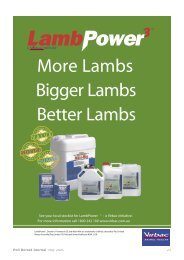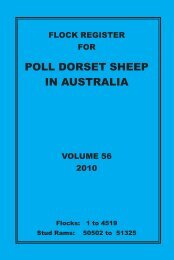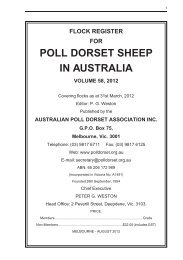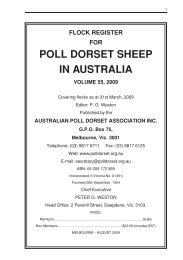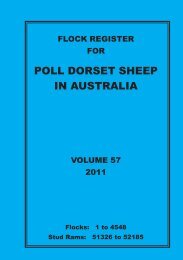2007 flock register vol 53.pdf - Australian Poll Dorset Association Inc
2007 flock register vol 53.pdf - Australian Poll Dorset Association Inc
2007 flock register vol 53.pdf - Australian Poll Dorset Association Inc
You also want an ePaper? Increase the reach of your titles
YUMPU automatically turns print PDFs into web optimized ePapers that Google loves.
Guidance to Breeders and Inspectors<br />
C.INSPECTION OF REGISTERED FLOCK ON OWNER’S PROPERTY<br />
1. Courtesy<br />
Courtesy and mutual understanding should be the keynote of a Flock Inspection.<br />
It should be, and usually is, an interesting and pleasant occasion when two or<br />
three stud breeders get together and chat over <strong>Association</strong> affairs, swap<br />
experiences, check over the Breeders <strong>flock</strong> and discuss his particular problems.<br />
2. Culling<br />
The visiting Inspectors check to see that the <strong>Association</strong> regulations regarding<br />
tattooing, are carried out; that a reasonable standard is being maintained and<br />
may possibly cull one or two animals with dangerous breeding potential as a<br />
guide to the Breeder. But only if necessary.<br />
It is true that some Breeders leave all their culling to the Inspectors, and these<br />
should be treatedaccordingly.However,mostresponsibleBreedersdotheirown<br />
classing and culling with great care.<br />
There are some Inspectors who feel that they have not done their job properly<br />
unless they cull a few animals. This attitude is wrong.<br />
3. Flock Assessment<br />
The Inspectors, having examined a Breeder’s entire <strong>flock</strong>, are in a position to<br />
assess the main f lock strengths and weaknesses. No matter how able and<br />
experienced the Breeder, he can benefit from such an assessment from the<br />
visiting Inspectors who gain an overall picture not obvious to the man who lives<br />
with his sheep and sees them daily.<br />
4. Two Suggestions for the Inspector<br />
The Flock Inspector must beware of two pitfalls. Firstly, he must not confuse old<br />
age, or low condition, with poor quality. Secondly, he must realise that the man<br />
who has yarded his <strong>flock</strong> for inspection is proud of his <strong>flock</strong>. Over the years, he<br />
has planned it and bred it. This stud is his creation - and like any other creative<br />
artist displaying his work to another artist - he is sensitive about it. Feelings can<br />
be hurt and resentment aroused by unconstructive or tactless criticism - or by<br />
an officious or dictatorial manner.<br />
5. And Two for the Breeder<br />
On the other hand, the Breeder whose <strong>flock</strong> is being inspected must also realise<br />
certain things.<br />
Firstly, his attitude towards inspections should be governed by the knowledge<br />
that they are of great value to the Breed in the maintenance of Breed standards<br />
and Breed purity; and in engendering confidence in, and demand for, his product.<br />
Secondly, he must realise that the Inspector has been appointed by the<br />
<strong>Association</strong> to do a job, which will cause the Inspector inconvenience, time and<br />
expense; that the Inspector is not doing the job by choice, but in the interests of<br />
the <strong>Association</strong> and the Breed. He should not be taken for granted.<br />
6. Expulsion<br />
A Breeder who is completely indifferent to the good name of the Breed or the<br />
<strong>Association</strong>, and whose conduct and breeding methods make a farce of<br />
<strong>register</strong>ed stud breeding, does more harm inside the <strong>Association</strong> than out of it.<br />
51



